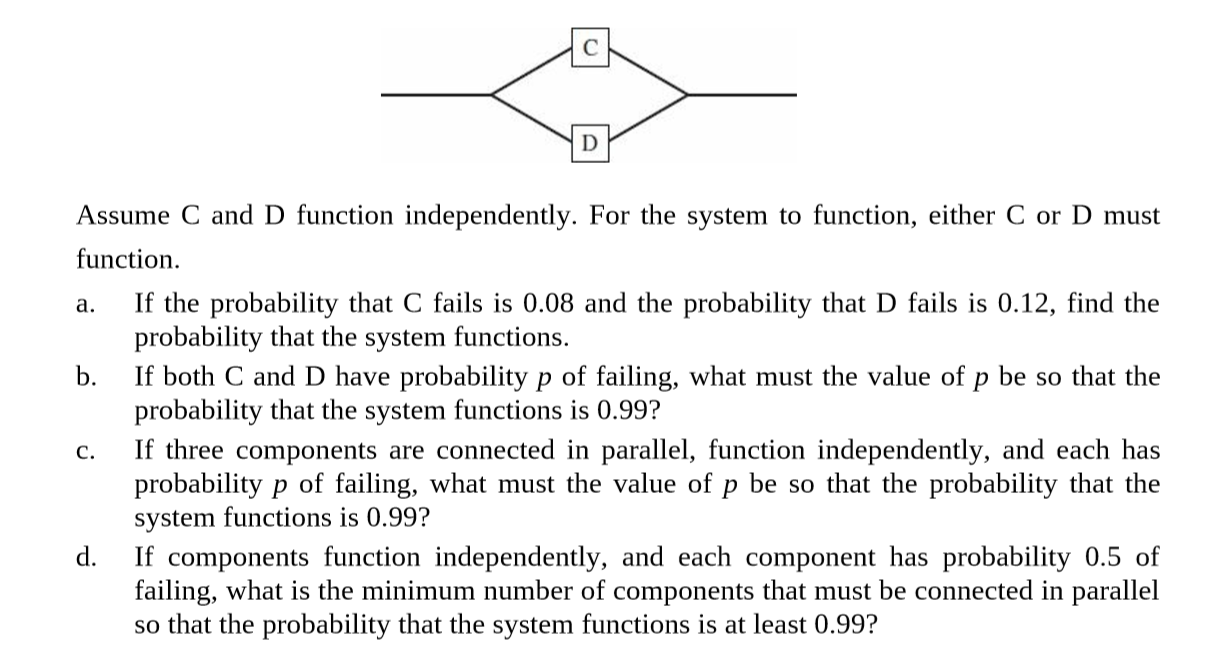A system contains two components, C and D, connected in parallel diagram. as shown in the Assume C and D function independently. For the system to function, either C or D must function. If the probability that C fails is 0.08 and the probability that D fails is 0.12, find the probability that the system functions. If both C and D have probability p of failing, what must the value of p be so that the probability that the system functions is 0.99? If three components are connected in parallel, function independently, and each has probability p of failing, what must the value of p be so that the probability that the system functions is 0.99? If components function independently, and each component has probability 0.5 of failing, what is the minimum number of components that must be connected in parallel so that the probability that the system functions is at least 0.99? a. b. C. d.
A system contains two components, C and D, connected in parallel diagram. as shown in the Assume C and D function independently. For the system to function, either C or D must function. If the probability that C fails is 0.08 and the probability that D fails is 0.12, find the probability that the system functions. If both C and D have probability p of failing, what must the value of p be so that the probability that the system functions is 0.99? If three components are connected in parallel, function independently, and each has probability p of failing, what must the value of p be so that the probability that the system functions is 0.99? If components function independently, and each component has probability 0.5 of failing, what is the minimum number of components that must be connected in parallel so that the probability that the system functions is at least 0.99? a. b. C. d.
Algebra and Trigonometry (MindTap Course List)
4th Edition
ISBN:9781305071742
Author:James Stewart, Lothar Redlin, Saleem Watson
Publisher:James Stewart, Lothar Redlin, Saleem Watson
Chapter10: Systems Of Equations And Inequalities
Section10.CR: Chapter Review
Problem 3CC: What is a system of linear equations in the variables x, y, and z?
Related questions
Question

Transcribed Image Text:A system contains two components, C and D, connected in parallel
diagram.
as shown in the

Transcribed Image Text:Assume C and D function independently. For the system to function, either C or D must
function.
If the probability that C fails is 0.08 and the probability that D fails is 0.12, find the
probability that the system functions.
If both C and D have probability p of failing, what must the value of p be so that the
probability that the system functions is 0.99?
If three components are connected in parallel, function independently, and each has
probability p of failing, what must the value of p be so that the probability that the
system functions is 0.99?
If components function independently, and each component has probability 0.5 of
failing, what is the minimum number of components that must be connected in parallel
so that the probability that the system functions is at least 0.99?
a.
b.
C.
d.
Expert Solution
This question has been solved!
Explore an expertly crafted, step-by-step solution for a thorough understanding of key concepts.
This is a popular solution!
Trending now
This is a popular solution!
Step by step
Solved in 2 steps with 4 images

Recommended textbooks for you

Algebra and Trigonometry (MindTap Course List)
Algebra
ISBN:
9781305071742
Author:
James Stewart, Lothar Redlin, Saleem Watson
Publisher:
Cengage Learning

Elementary Linear Algebra (MindTap Course List)
Algebra
ISBN:
9781305658004
Author:
Ron Larson
Publisher:
Cengage Learning

College Algebra
Algebra
ISBN:
9781305115545
Author:
James Stewart, Lothar Redlin, Saleem Watson
Publisher:
Cengage Learning

Algebra and Trigonometry (MindTap Course List)
Algebra
ISBN:
9781305071742
Author:
James Stewart, Lothar Redlin, Saleem Watson
Publisher:
Cengage Learning

Elementary Linear Algebra (MindTap Course List)
Algebra
ISBN:
9781305658004
Author:
Ron Larson
Publisher:
Cengage Learning

College Algebra
Algebra
ISBN:
9781305115545
Author:
James Stewart, Lothar Redlin, Saleem Watson
Publisher:
Cengage Learning

Algebra for College Students
Algebra
ISBN:
9781285195780
Author:
Jerome E. Kaufmann, Karen L. Schwitters
Publisher:
Cengage Learning

Glencoe Algebra 1, Student Edition, 9780079039897…
Algebra
ISBN:
9780079039897
Author:
Carter
Publisher:
McGraw Hill

Linear Algebra: A Modern Introduction
Algebra
ISBN:
9781285463247
Author:
David Poole
Publisher:
Cengage Learning